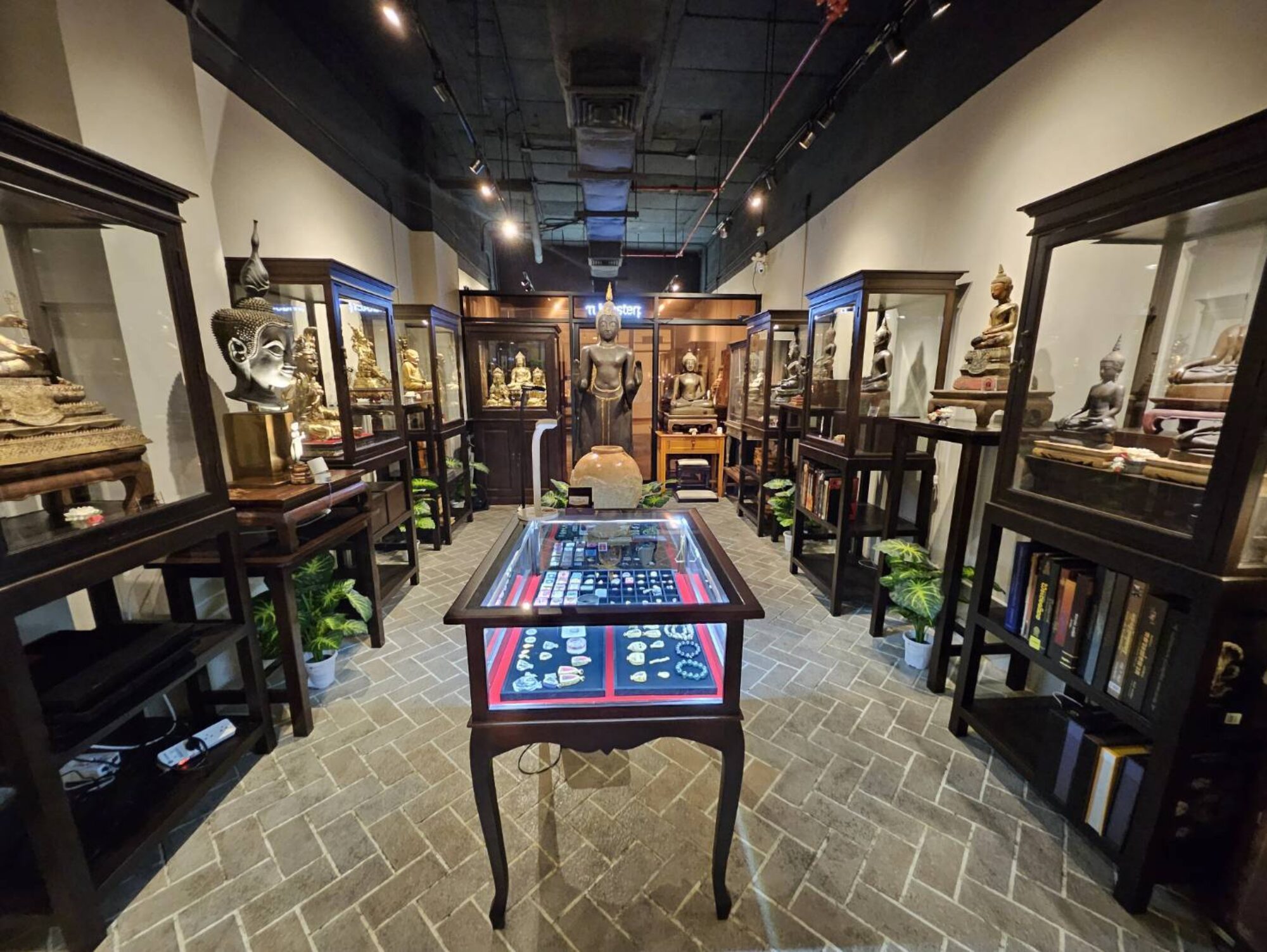
จากลักษณะทางศิลปะของพระบูชาองค์นี้ มีจุดเด่นหลายประการที่สอดคล้องกับ ศิลปะสุโขทัย-กำแพงเพชร (หรือที่เรียกว่า ศิลปะสุโขทัยสายกำแพงเพชร ซึ่งพัฒนาในเขตเมืองลูกหลวงของสุโขทัย) ดังนี้:
พระบูชาองค์นี้ หากพิจารณาจากพุทธศิลป์และลักษณะเด่นที่คล้ายกับ ศิลปะสุโขทัยสายกำแพงเพชร สามารถประมาณอายุการสร้างได้ในช่วง พุทธศตวรรษที่ 19–20 ซึ่งตรงกับ ค.ศ. 1350–1500
รายละเอียดช่วงเวลา
- ยุคสุโขทัยตอนปลาย:
- ประมาณ ค.ศ. 1350–1400
- เป็นช่วงที่ศิลปะสุโขทัยรุ่งเรืองสูงสุด มีการสร้างพระพุทธรูปเน้นความสง่างาม พระรัศมีเปลวไฟเป็นลักษณะเฉพาะ
- ยุคอยุธยาตอนต้น (ได้รับอิทธิพลจากสุโขทัย):
- ประมาณ ค.ศ. 1400–1500
- ยังคงรักษาเอกลักษณ์ศิลปะสุโขทัยไว้ แต่เริ่มมีการผสมผสานรูปแบบใหม่ เช่น พระพักตร์กลมขึ้นเล็กน้อย
ข้อสันนิษฐานเบื้องต้น
จากการพิจารณารายละเอียด องค์พระบูชาองค์นี้มีความเป็นไปได้ที่จะถูกสร้างขึ้นในช่วง ปลายศิลปะสุโขทัย ราว ค.ศ. 1400–1500 ซึ่งตรงกับปลายพุทธศตวรรษที่ 19 หรือต้นพุทธศตวรรษที่ 20
ลักษณะที่สอดคล้องกับศิลปะสุโขทัย-กำแพงเพชร
- พระพักตร์รูปไข่:
- พระพักตร์ค่อนข้างเรียวยาว มีความละมุนละไม พระเนตรหลุบต่ำ แสดงความสงบเยือกเย็น อันเป็นลักษณะเด่นของศิลปะสุโขทัย
- พระรัศมีเปลวไฟ:
- เป็นเอกลักษณ์สำคัญของพระพุทธรูปสุโขทัย โดยเฉพาะสายกำแพงเพชรที่เน้นพระรัศมีเป็นเปลวไฟสูงสง่า สื่อถึงความสว่างแห่งปัญญา
- จีวรแนบเนื้อ:
- ลักษณะจีวรบางแนบลำตัว โอบเฉียงผ่านไหล่ซ้าย เผยให้เห็นสัดส่วนที่งดงามของพระวรกาย สะท้อนถึงศิลปะสุโขทัยที่นิยมสร้างพระพุทธรูปให้ดูมีชีวิตชีวา
- ปางมารวิชัย:
- พระบูชาองค์นี้อยู่ใน ปางมารวิชัย ซึ่งเป็นปางยอดนิยมในศิลปะสุโขทัย-กำแพงเพชร
- ฐานรองรับองค์พระ:
- ฐานกลีบบัวที่รองรับองค์พระ สะท้อนลักษณะการสร้างที่พบได้ในศิลปะกำแพงเพชร
จุดสังเกตที่อาจเป็นสุโขทัยสายกำแพงเพชร
- พระเศียรที่มีพระรัศมีเปลวไฟเป็นเอกลักษณ์
- ลำพระองค์และพระพาหาที่เรียวยาว สง่างาม
- พระโอษฐ์ยิ้มพองาม (เรียกว่ายิ้มแบบ “ศิลปะสุโขทัย”)
ตำนานและความเชื่อในศาสนา
พระบูชาในลักษณะนี้นิยมสร้างขึ้นเพื่อเป็นตัวแทนของพระพุทธเจ้า สื่อถึงชัยชนะของธรรมะที่มีต่ออธรรม เชื่อกันว่าผู้บูชาจะได้รับพลังแห่งสติ ปัญญา และความสงบสุข
- ปางมารวิชัย: สื่อถึงการขจัดอุปสรรคและปัญหาในชีวิต ให้ประสบความสำเร็จ
- เปลวเพลิงที่ยอดพระเศียร: เป็นสัญลักษณ์ของความสว่างทางปัญญาและการตรัสรู้
ความศักดิ์สิทธิ์และการบูชา
- เสริมความเจริญรุ่งเรือง: เหมาะสำหรับผู้ที่ต้องการบูชาเพื่อเสริมดวงชะตา และความสำเร็จในชีวิต
- คุ้มครองป้องกันภัย: เชื่อกันว่าพระพุทธรูปในปางนี้มีพลังช่วยขจัดสิ่งชั่วร้ายและปัดเป่าอุปสรรค
- สร้างสมาธิและสติปัญญา: การบูชาพระบูชาลักษณะนี้เหมาะสำหรับการนั่งสมาธิ และการเจริญภาวนา
ยุคสมัยที่คาดการณ์
- องค์นี้อาจอยู่ในช่วงปลายสุโขทัยหรือต้นอยุธยา เนื่องจากมีลักษณะของศิลปะสุโขทัยเด่นชัด เช่น พระพักตร์รูปไข่ พระรัศมีเปลวไฟ และจีวรแนบเนื้อ
สรุป: พระบูชาองค์นี้ถือเป็นงานศิลป์ที่แสดงถึงศรัทธาในพระพุทธศาสนาอย่างลึกซึ้ง ทั้งด้านความงดงามทางศิลปะและความเชื่อทางจิตวิญญาณ เหมาะอย่างยิ่งสำหรับการบูชาเพื่อความเป็นสิริมงคลและการขัดเกลาจิตใจให้สงบสุข
Sukhothai Buddha statue, Kamphaeng
From the artistic characteristics of this Buddha image, there are several outstanding features that are consistent with Sukhothai-Kamphaeng Phet art (or Sukhothai Kamphaeng Phet style art, which developed in the area of the Sukhothai city of Luang), as follows:
This Buddha image, if considering the Buddhist art and outstanding characteristics that are similar to Sukhothai Kamphaeng Phet style art, can be estimated to be created in the 19th–20th Buddhist century, which corresponds to 1350–1500 AD.
Details of the period
Late Sukhothai period:
Around 1350–1400 AD
This is the period when Sukhothai art flourished the most. Buddha images were created that emphasized elegance. The flame halo is a unique characteristic.
Early Ayutthaya period (influenced by Sukhothai):
Around 1400–1500 AD
Still retaining the identity of Sukhothai art, but starting to incorporate new styles, such as a slightly rounder face.
Initial assumption
From considering the details, it is possible that this Buddha image was created during Late Sukhothai art, around 1400–1500 AD, which corresponds to the end of the 19th or the beginning of the 20th Buddhist century.
Characteristics consistent with Sukhothai-Kamphaeng Phet art
Oval face:
The face is rather long and slender, with a gentle, downward-set eyes, showing calmness and composure, which are distinctive characteristics of Sukhothai art.
Flame halo:
This is an important characteristic of Sukhothai Buddha images, especially Kamphaeng Phet style, which emphasizes a tall, majestic flame halo, conveying the brightness of wisdom.
Close-fitting robe:
The thin robe is close to the body, diagonally over the left shoulder, revealing the beautiful proportions of the body, reflecting Sukhothai art, which likes to create Buddha images that look lively.
Maravijaya posture:
This Buddha image is in the Maravijaya posture, which is a popular posture in Sukhothai-Kamphaeng Phet art.
Pedestal:
The lotus petal base supporting the Buddha image reflects the construction characteristics found in Kamphaeng Phet art.
A notable point may be the Sukhothai Kamphaeng Phet style.
The head with a flame halo is a unique characteristic.
The body and arms are long and graceful.
The mouth smiles in a moderate manner (called the “Sukhothai art” smile).
Legends and beliefs in religion
This type of Buddha image is usually created to represent the Lord Buddha, symbolizing the victory of righteousness over evil. It is believed that the worshipper will receive the power of mindfulness, wisdom, and peace.
Pang Mara Vijaya: Symbolizing the elimination of obstacles and problems in life, leading to success.
Flame at the top of the head: Symbolizing the brightness of wisdom and enlightenment.
Sacredness and worship
Enhance prosperity: Suitable for those who want to worship to enhance their destiny and success in life.
Protect from danger: It is believed that the Buddha image in this posture has the power to eliminate evil and dispel obstacles.
Build concentration and wisdom: Worshiping this type of Buddha image is suitable for meditation and spiritual practice.
Estimated era
This image may be from the late Sukhothai or early Ayutthaya periods, as it has distinct Sukhothai art characteristics, such as an oval face, flame halo, and a robe that clings to the body.
Conclusion: This Buddha image is considered a work of art that deeply reflects faith in Buddhism, both in terms of artistic beauty and spiritual beliefs. It is ideal for worshipping for good fortune and to purify the mind for peace.
素可泰甘烹佛像
从这尊佛像的艺术特点来看有几个突出的特点与素可泰-甘烹碧艺术(也称为素可泰艺术,甘烹碧线发展于素可泰的 Luk Luang 地区)如下:
此佛像如果考虑到与佛教艺术和特征相似的素可泰艺术,甘烹碧线建筑年龄可估计在以下范围内19世纪至20世纪佛教世纪,相当于公元1350年至1500年。
期间详情
素可泰后期:
大约公元 1350 年至 1400 年。
那是素可泰艺术的鼎盛时期。佛像的制作强调优雅。火焰的半径是唯一的。
大城府早期(受素可泰影响):
大约公元 1400 年至 1500 年。
依然保持着素可泰艺术的独特性。但新的风格开始结合起来,比如他的脸稍微圆一些。
基本假设
从细节考虑此佛像很可能是在这一时期创作的。素可泰晚期艺术,约1400年至1500年,相当于19世纪末或20世纪初。
与素可泰-甘烹碧艺术相一致的特征
椭圆形脸:
他的脸很瘦。它很温柔。他的眼睛垂了下来。表现出冷静这是素可泰艺术的一个显着特征
火焰半径:
它是素可泰佛像的一个重要标识。尤其是甘烹碧系列,强调高雅火焰的荣耀。它代表着智慧之光。
紧身长袍:
一件薄薄的长袍贴在身上斜缠于左肩展现优美的身材比例反映素可泰艺术中流行的佛像创作,使其看起来生动活泼。
庞·马拉维奇:
这尊佛像呈 Maravichai 姿势,这是素可泰-甘烹碧艺术中流行的姿势。
支撑佛像的底座:
莲瓣底座支撑着佛像。反映了甘烹碧艺术中的建筑风格。
可能是素可泰、甘烹碧线的地标
他的头顶有着独特的火焰光环。
他的身体和手臂修长而优雅。
他的嘴角笑得很美。 (这就是所谓的微笑。 《素可泰艺术》)
传说和宗教信仰
这种风格的佛像通常是为了代表佛陀而建造的。它代表了 Dharma 对 Adharma 的胜利。人们相信崇拜者将获得正念、智慧与和平的力量。
Pang Maravichai:代表消除生活中的障碍和问题。获得成功
头顶火焰:象征智慧的启迪和启迪。
圣洁与敬拜
旺财:适合想拜佛以旺财的人士。和人生的成功
护佑:相信此姿势的佛像具有辟邪、辟障的力量。
培养定力和智慧:这种礼佛适合冥想。和冥想
预期时代
这一幅可能是素可泰晚期或大城时期早期的。因为它具有鲜明的素可泰艺术特征,比如椭圆形的脸。火焰半径和贴在皮肤上的长袍
结论:这尊佛像被认为是表达对佛教深厚信仰的艺术品。无论是在艺术美感上,还是在精神信仰上。非常适合祈求吉祥和净化心灵。
